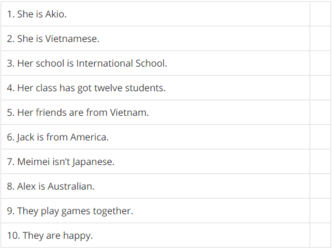VI. Choose the best answer
1. The villagers are trying to learn English _____ they can communicate with foreign customers.
A. so that B. in order that C. A and B are correct
2. I’ve been to a _____ village in Hue!
A. conical hat making B. making conical hat C. making conical hats
3. _____ we had eaten lunch, we went to Non Nuoc marble village to buy some souvenirs.
A. After B. Before C. By the time
4. Do you think that the various crafts remind people _____ a specific region?
A. about B. of C. for
5. _____ this hand-embroidered picture was expensive, we bought it.
A. As B. Because C. Even though
6. Conical hat making in the village has been passed _____ from generation to generation
A. on B. down C. up
7. This department store is an attraction in my city _____ the products are of good quality.
A. when B. because C. though
8. A conical hat is a well-known handicraft, not only in Viet Nam, _____ all around the world.
A. and B. but C. so
9. This is called a Chuong conical hat _____ it was made in Chuong village.
A. but B. so C. since
10. They can’t because we have lots of products. They make some and other people make _____.
A. the rest B. the last C. the other
11. I look forward to _____ you soon.
A. see B. seeing C. seen
12. It’s a nice place for _____ who love nature and quietness.
A. this B. that C. those
13. You like history, so Viet Nam National Museum of History is a _____ place.
A. must-see B. must-be seen C. must-be seeing
14. The artisan ______ this statue in bronze.
A. moulded B. cast C. carved
15. The artisans in my village can live _____ basket weaving.
A. for B. on C. up
16. There is a big _____of handicrafts made by di¬fferent craft villages.
A. collect B. collection C. collector
17. Last week we had a memorable trip to a new zoo on the ______ of the city.
A. outskirts B. middle C. centre
18. Then we had a delicious lunch ______ by Nga and Phuong.
A. prepare B. to prepare C. prepared
19. I invited her to join our trip to Trang An, but she ______ down my invitation.
A. passed B. sat C. turned
20. We have to try harder so that our handicrafts can keep _____ theirs.
A. on B. up C. up with





1 . to play 2. from 3. have been 4.hasn't written 5.came 6. was/wrote 7.went/was
1. We used ( mình nghĩ chỗ này thiếu " to" ) ( played / play / playing ) hide and seek.
2. Life in Vietnam is different ( to / with / from ) that in Malaysia.
3. They ( are / were / have been ) pen pal friends since they wrote to each other.
4. Hoa ( haven't written ( chỗ này đề bài sai ) / hasn't written / didn't write ) the letter for ten year.
5. The Mark family ( come / came / has come ) to the USA twenty years ago.
6. When my brother ( is / was / were ) in army, i (Write / wrote / has written ) to him twice a month.
7. The last time i ( have gone / go / went ) to HCM city ( is / was / were ) in August.